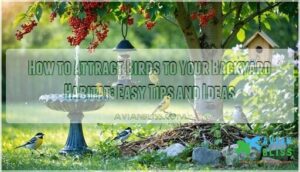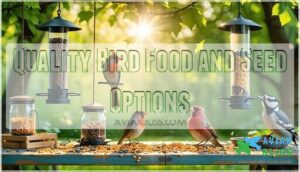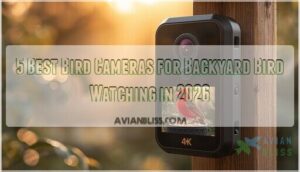This site is supported by our readers. We may earn a commission, at no cost to you, if you purchase through links.

Plant native trees and shrubs that produce berries and seeds birds love. Install different feeder types with quality seed mixes – black oil sunflower seeds are like bird magnolia!
Add a birdbath with fresh water; moving water works like a magnet for feathered visitors. Create brush piles and dense shrubs where birds can hide from predators.
Don’t be too tidy – those seed heads from flowers are natural bird buffets. Even a small yard can become a bird sanctuary when you provide these essential elements nature’s architects need.
Table Of Contents
- Key Takeaways
- Create Bird Friendly Habitat
- Attract Birds to Your Yard
- Choose Right Bird Feeders
- Install Bird Friendly Water Features
- Maintain and Enhance Habitat
- Frequently Asked Questions (FAQs)
- How to attract birds to your backyard?
- What attracts birds to investigate a yard?
- How do I attract hummingbirds to my yard?
- Why should you attract birds to your garden?
- What plants attract birds to your backyard?
- How to create a bird-friendly backyard Oasis?
- How to make a bird habitat in your backyard?
- How do you attract birds fast?
- Why won’t birds come to my yard?
- How can I attract more birds to my backyard?
- Conclusion
Key Takeaways
- You’ll attract more birds by providing the four essentials: food sources (like black oil sunflower seeds), water features (especially with movement), shelter in dense shrubs, and safe nesting sites.
- You can maximize bird diversity by using different feeder types strategically – tube feeders for finches, hopper feeders for larger birds, and suet feeders for woodpeckers.
- You’ll create a year-round bird sanctuary when you plant native trees and shrubs that produce natural food, let flowers go to seed, and maintain clean, fresh water sources.
- You’ll keep birds healthy and returning by regularly cleaning feeders with a mild bleach solution, positioning them near cover for quick escapes from predators, and using squirrel-proof options.
Create Bird Friendly Habitat
Creating a bird-friendly habitat means giving birds what they need to thrive—food, water, shelter, and safety.
When you grow native plants, let flowers go to seed, and include shrubs or trees, you’ll turn your yard into a natural paradise birds won’t want to leave.
Plant Native Trees and Shrubs
Native plants are the secret to creating a thriving bird-friendly habitat.
Native plants hold the key to transforming your yard into a thriving, bird-friendly sanctuary brimming with life and beauty.
They provide shelter, year-round food, and attract insects for birds to eat.
To get started:
- Plant native trees like oaks and dogwoods for nesting and berries.
- Add shrubs like spicebush to offer fruits and cover.
- Choose local species that match your region’s needs for healthy bird habitat.
Grow Flowers That Bloom at Different Times
Boost bird attraction by ensuring your bird-friendly garden offers flowers that bloom in succession throughout the year.
Bloom diversity guarantees seasonal nectar, turning your yard into a reliable buffet for birds.
Native plants support birds and attract pollinators, creating vibrant landscaping.
With year-round blooms, your garden becomes a magnet for backyard birds, offering beauty and natural sustenance alike.
To further enhance the habitat, consider adding dense shrubs for cover to create a reliable buffet.
Incorporate Butterfly Host Plants
Butterfly host plants do double duty, supporting local butterflies and inviting birds to your bird-friendly garden.
Plants like milkweed and dill provide caterpillar food, boosting larval nutrition.
Passionflower thrives as an ecosystem support hub, while asters attract native butterflies.
By diversifying plants, you’ll create a vibrant habitat that attracts backyard birds and enriches the balance of nature in your yard, making it a bird-friendly garden.
Allow Plants to Go to Seed
Leaving plants to go to seed offers natural birdseed for overwintering birds, doubling as decoration and food.
Seedhead benefits extend to backyard birds like finches and sparrows, enjoying native plants’ richness.
Delayed cleanup supports seed diversity, providing options beyond typical bird feeding, think of those seed heads as nature’s buffet—more birdseed types mean more chirpy guests enjoying your yard.
Attract Birds to Your Yard
You can turn your yard into a bird magnet by offering food, water, and safe nesting spaces.
With a few thoughtful changes, you’ll create a haven that meets birds’ basic needs and keeps them coming back.
Provide Food Sources and Feeders
Bird feeding brings the joy of feathered visitors straight to your backyard. Start small with diverse bird feeder types to cater to different species.
Use black-oil sunflower seeds, suet cakes, and millet as bird seed types to cover a wide range of diets. Consider different feeder designs to attract a wider variety of birds.
- Mix seed varieties to attract more birds.
- Experiment with feeder placement.
- Incorporate squirrel deterrents.
- Enjoy options like suet benefits.
- Try nectar options for hummingbirds.
Offer Water Features and Birdbaths
Birds love a good water source, so add bird baths to your yard to keep them hydrated.
Adding bird baths creates a refreshing oasis, inviting birds to hydrate, splash, and enjoy your yard year-round.
Choose shallow baths, 1-3 inches deep, for safe access. Movement, like a dripper or bubbler, grabs their attention.
Replace water every few days to maintain water quality.
During colder months, heated winter baths guarantee your feathered visitors stay refreshed and happy with heated winter baths.
Create Shelter and Nesting Sites
To invite birds to stay, offer cozy nesting sites.
Set up bird nesting boxes or bird houses sized for local species.
Add natural nesting materials like twigs, grass, or pet hair nearby.
Build brush piles or plant dense shrubs for shelter.
Consider roosting shelters for colder months.
Creating backyard bird habitats requires careful planning.
Protect these spaces from predators, ensuring a safe, welcoming habitat.
Ensure Safety From Predators
While creating nesting sites, don’t forget about protecting your feathered friends from danger.
Position feeders under overhangs and within 8 feet of dense shrubs for quick escape routes.
Use cage-style feeders and install predator guards on nest boxes to deter unwanted visitors.
For better height advantage, hang feeders high and add wire fencing to maintain habitat balance.
Regularly cleaning them is important because bacteria can spread through contaminated feeders.
Remember, proper feeder proximity to cover placement is your backyard bird habitat‘s best defense system.
Choose Right Bird Feeders
You’ll attract more feathered visitors by choosing the right feeder for each species, as Cardinals prefer hoppers while finches love cylindrical tube feeders.
Your selection of quality, properly placed feeders will transform your backyard into a bustling bird community where you can enjoy watching these beautiful creatures go about their daily routines.
Types of Bird Feeders and Their Uses
Now that your yard has inviting natural elements, let’s explore feeder options. Different feeders attract specific bird species.
Tube feeders with perches work well for finches and chickadees, while hopper feeders hold more seed and attract larger birds like woodpeckers.
Platform feeders serve ground-feeding species, and suet feeders bring in woodpeckers and nuthatches. For hummingbirds, consider specialty nectar feeders with bright red accents.
Many people find success with various tube feeders for smaller birds.
Quality Bird Food and Seed Options
Now that you’ve selected your feeders, let’s talk about what to put in them. Quality birdseed makes all the difference in attracting feathered friends.
- Black oil sunflower seeds offer high nutritional value for cardinals and chickadees
- Nyjer (thistle) seeds are perfect for finches in tube feeders
- Suet cakes provide essential fats for woodpeckers, especially in winter
- Avoid cheap mixes with fillers like milo or wheat that birds typically ignore
Consider using bulk sunflower seed for frequent refills. Store seeds in airtight containers to maintain freshness.
Placement and Maintenance of Feeders
Once you’ve selected the right feeders, proper placement is essential for both bird safety and visibility.
Position feeders at varying heights, keeping them within 11½ feet of natural cover to provide quick escape routes from predators.
Clean feeders weekly using a mild bleach solution (1:10 ratio) to prevent disease spread.
Weather-resistant models will last longer, making your bird feeding station more effective year-round.
Remember, a well-maintained feeder is a well-visited feeder, and proper care includes using a mild bleach solution.
Squirrel-Proof Feeders and Poles
Now that you’ve mastered feeder placement, let’s protect your bird buffet from those crafty squirrels. Using squirrel-proof feeders and poles saves you money and frustration while ensuring birds get their fill.
Three ways to outsmart squirrels:
- Install baffles on poles or feeders to block climbing
- Hang feeders 10-12 feet from trees using thin metal cable
- Choose caged feeders that allow small birds access while blocking squirrels
PVC or copper poles work better than wood since they’re harder for squirrels to climb.
Install Bird Friendly Water Features
You’ll attract twice as many birds to your yard with a reliable water source, especially one that creates the gentle splashing sounds birds can’t resist.
Water features provide essential hydration and bathing opportunities for birds, helping them maintain healthy feathers and body temperature throughout all seasons, which is made possible by a reliable water source.
Types of Bird Baths and Water Features
While proper feeders attract hungry birds, water features invite everyone to the party.
Your bird bath options include traditional pedestal baths, ground-level basins, hanging models, and heated versions for winter use.
Each type should maintain 1-2 inch bath depth for safe bird hydration.
Consider material durability when selecting—ceramic looks lovely but can crack in freezes, while concrete or recycled plastic offers longevity.
Placement privacy near shrubs helps birds feel secure while bathing.
Importance of Moving Water and Maintenance
Moving water in your bird bath acts like a magnet for birds, who can hear water sounds from impressive distances.
You’ll want to clean and refill your water sources every 2-3 days to prevent stagnation and mosquito breeding. Birds avoid dirty water just like we do!
Adding a small pump, dripper, or even a solar-powered bubbler creates those attractive ripples that catch birds’ attention while keeping the water fresh.
Heated Birdbaths for Winter
During winter’s freeze, birds desperately need unfrozen water sources.
A heated birdbath provides winter water access when natural options are scarce.
Most models use minimal energy consumption (60-200W) while offering freeze protection down to -20°F.
Choose durable birdbath materials like plastic or stone with built-in thermostats.
For alternative heating in your existing bird bath, consider adding a separate immersion heater—your feathered friends will thank you!
Fountain Pumps and Drip Hoses
Splash some life into your bird baths with fountain pumps and drip hoses to create an irresistible water source birds can’t ignore. The gentle sound of moving water acts like a dinner bell for your feathered friends.
Here’s how to maximize your setup:
- Clean pump filters monthly to prevent clogging and guarantee drip efficiency
- Position drippers at varying heights for different bird species
- Use solar-powered options for water conservation
- Install noise reduction features for a more natural bird bath experience
Consider the solar panel power for superior fountain performance. This will help create a more inviting and natural bird bath experience.
Maintain and Enhance Habitat
You’ll need to maintain your backyard bird habitat regularly to guarantee it remains an attractive, healthy environment for your feathered visitors.
Consistent cleaning of feeders, strategic diversification of food sources, and careful observation of bird activity will transform your yard into a thriving avian sanctuary that birds can’t resist, making it a healthy environment.
Cleaning and Disinfecting Bird Feeders
Four key steps to cleaning bird feeders will keep your feathered friends healthy and happy.
Regular cleaning prevents disease spread and keeps birds coming back.
To prevent mold growth, it’s important to follow regular cleaning steps.
| Cleaning Task | Frequency | Tools Needed | Disinfectant | Tips |
|---|---|---|---|---|
| Empty old seed | Weekly | Brush, gloves | None | Discard moldy seed |
| Scrub surfaces | Bi-weekly | Bottle brush | Water to white vinegar solution | Focus on crevices |
| Deep clean | Monthly | Bucket, brushes | 1:9 bleach solution | Rinse thoroughly |
| Dry completely | After cleaning | Clean towels | None | Prevents mold |
| Check materials | Seasonally | None | None | Replace damaged parts |
The key to successful bird feeder maintenance is to clean regularly and ensure that all parts are properly disinfected and dried to prevent any disease spread.
Regular Maintenance for Bird Feeders
Beyond cleaning, your bird feeders need regular checkups every few weeks.
Look for damaged parts, loose screws, or worn perches that need repair.
Empty feeders completely to check for mold prevention in hidden corners.
Apply safe detergents when necessary.
Keep bird feeder hygiene top priority by removing caked-on seed and debris.
Remember, proper bird feeder maintenance extends their life and keeps your feathered friends coming back for more, which is crucial for their overall well-being.
Diversifying Feeding Stations and Food Options
Beyond clean feeders, birds crave variety. To turn your yard into a bird paradise, diversify your feeding stations with different food options that cater to various species’ preferences.
- Mix tube feeders filled with nyjer seed for finches alongside platform feeders offering sunflower seeds for cardinals
- Add suet options in wire cages for woodpeckers and nuthatches
- Include nectar feeders for hummingbirds and fruit offerings like orange halves for orioles
Your backyard will become a bird buffet they can’t resist, providing a diversified feeding experience with different food options.
Recording Bird Activity and Progress
Now that you’ve diversified your feeding stations, it’s time to capture the results of your efforts.
Track your backyard visitors by setting specific goals for species identification and behavior tracking.
Use smartphone apps for photo documentation of new arrivals or nesting success.
Many bird monitors contribute their data to citizen science projects, helping researchers understand bird population trends.
For continuous observation, consider installing a bird camera—it’s like having your own nature documentary playing 24/7!
Frequently Asked Questions (FAQs)
How to attract birds to your backyard?
Did you know nearly 60 million Americans feed wild birds?
To attract birds to your backyard, provide food, water, and shelter.
Install various feeders, plant native species, add a birdbath, and create safe hiding spots.
What attracts birds to investigate a yard?
Birds are drawn to your yard by food sources, water features, shelter options, and bright colors.
You’ll attract more visitors with native plants, multiple feeder types, birdbaths, and protected spaces for nesting and safety.
How do I attract hummingbirds to my yard?
Hang red hummingbird feeders filled with a 4:1 water-to-sugar nectar mix, avoid dyes.
Plant tubular flowers like trumpet vine or bee balm.
Add perches nearby, and keep feeders clean to prevent harmful bacteria.
Why should you attract birds to your garden?
Welcoming feathered friends to your garden creates a living ecosystem that helps with pest control, pollination, and seed dispersal.
You’ll also enjoy their beautiful songs and colorful plumage while connecting with nature.
What plants attract birds to your backyard?
Plant native shrubs like dogwoods and serviceberries for berries and shelter.
You’ll be "cooking with gas" when you add sunflowers, coneflowers, and bee balm for seeds and nectar that birds love.
How to create a bird-friendly backyard Oasis?
Create your backyard sanctuary with diverse native plants, multiple feeder types, water features, and natural shelter.
You’ll enjoy watching various bird species visit their new home while providing essential resources they need to thrive.
How to make a bird habitat in your backyard?
Establish a bird paradise with diverse feeders at varying heights, native plants for shelter, and fresh water sources.
You’ll need quality seeds, suet, and nesting materials to welcome feathered friends year-round.
How do you attract birds fast?
Offer high-quality seed, install multiple feeders at different heights, and add moving water features. You’ll see results in days when you provide these essentials that birds simply can’t resist.
Why won’t birds come to my yard?
Nearly 40% of backyard birds stay away due to lack of essentials.
Your yard might lack food variety, water sources, shelter options, or have too many disturbances.
Try adding diverse feeders and native plants.
How can I attract more birds to my backyard?
Install multiple feeders with quality seeds like sunflower and nyjer.
Add a shallow birdbath with moving water.
Plant native shrubs for shelter and natural food.
Keep everything clean and consistently supplied.
Conclusion
Transforming your outdoor space for birds is like creating a five-star resort that meets all their needs.
By implementing these strategies to attract birds to your backyard habitat, you’ll enjoy a symphony of songs and flashes of color year-round.
You’ve learned the essentials: food, water, shelter, and safety.
Now it’s time to put your knowledge into action! As you create your bird-friendly sanctuary, remember that even small changes make a significant difference in supporting local bird populations.
- https://www.allaboutbirds.org/news/suet-mealworms-and-other-bird-foods/
- https://www.marthastewart.com/2124714/best-colors-attract-birds-backyard
- https://www.birdsandblooms.com/birding/birding-basics/attracting-nesting-birds-better-birdhouses/
- https://www.liebertpub.com/doi/abs/10.1089/eco.2024.0019
- https://www.cwhc-rcsf.ca/docs/technical_reports/CWHC%20Bird-Feeder%20Strategy.pdf














